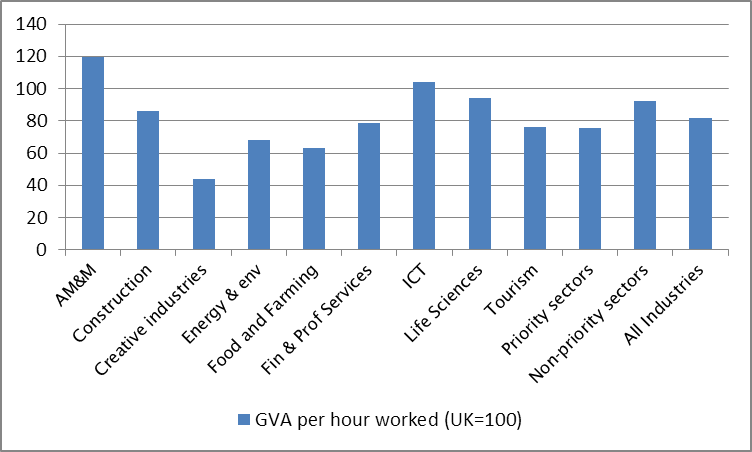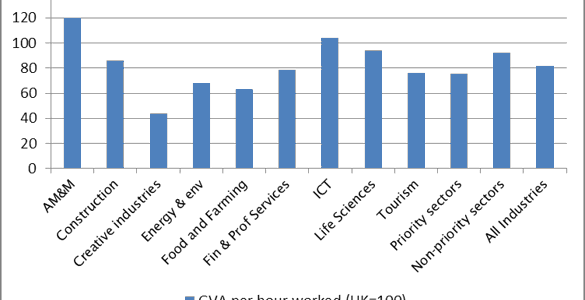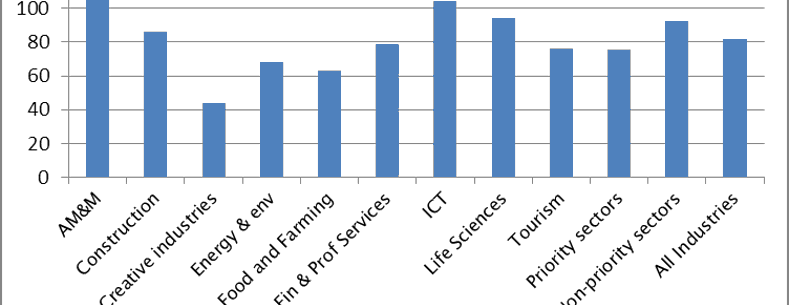4 October 2013
The Welsh Government focuses its business support activities on the following nine sectors which it has identified as being, or having the potential to be, key to the economy of Wales:
- Advanced materials & manufacturing
- Construction
- Creative industries
- Energy & environment
- Food and Farming
- Finance and Professional Services
- ICT
- Life Sciences
- Tourism
With the draft budget approaching it is worth looking again at the latest statistics published by the Welsh Government in August regarding the composition and performance of the sectors. The Welsh Government’s own analysis of the data highlighted a number of key findings, including:
- Almost 60,000 enterprises in Wales were in a priority sector in 2012, representing just under two thirds of VAT or PAYE registered enterprises in Wales.
- The 542,000 people in employment in the priority sectors in 2012 accounted for 43 per cent of total employment in Wales.
- The local authority with the greatest proportion of employment in the priority sectors in 2012 was Flintshire (55 per cent), whilst the lowest was in Conwy, Ceredigion and Merthyr Tydfil (all 37 per cent).
- The priority sector with the largest number of employee jobs in 2011 was the Financial & Professional Services sector (with 135,300). The sector with the smallest was Life Sciences (with 9,200).
- In 2011 GVA per hour worked (a measure of productivity) was higher in the priority sectors than that of the non-priority sectors (£27 vs. £20). The Financial and Professional Services sector had the highest GVA per hour worked (£45) whilst the Creative Industries had the lowest (£10).
- Full-time gross mean weekly earnings for employees in the priority sectors were slightly higher than those in non-priority sectors in 2012 (£524 vs. £518).
Alongside its own analysis the Welsh Government also published a comprehensive data set which shows that:
- In 2011 the priority sectors contributed 55 per cent of total GVA in Wales.
- In 2011 GVA per hour worked in the priority sectors in Wales stood at £27 – 76 per cent of the equivalent UK figure.
- Although the Financial and Professional Services sector had the highest GVA per hour worked in Wales in 2011 (£45) – this represented 78 per cent of the equivalent UK figure.
- There does not appear to be any significant under-representation in the priority sectors when looking at the profile of those in employment on the basis of disability, ethnicity or age.
- In 2012, men and women respectively accounted for 52 per cent and 48 per cent of the total number of people in employment in Wales. However, the gender split among people in employment in the priority sectors in Wales was quite different – 68 per cent were men, 32 per cent were women.
- Two priority sectors in Wales out-performed the UK average in 2011 in terms of GVA per hour worked – advanced materials and manufacturing (20 per cent higher in Wales), and ICT (4 per cent higher in Wales). Further detail is given in Figure 1.
Figure 1: Relative Productivity of Priority Sectors in Wales, 2011 (UK=100) Source: Welsh Government, Priority sector statistics, 2013 Article by Ben Stokes
Source: Welsh Government, Priority sector statistics, 2013 Article by Ben Stokes





